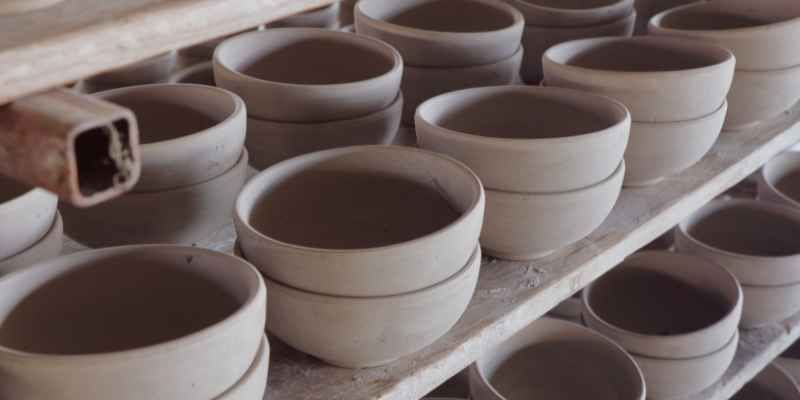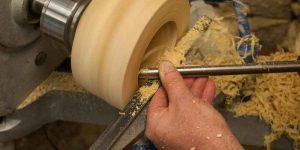Wood should be dried to a moisture content of around 10-15% before turning. Drying wood for turning can take up to one year per inch of thickness.
Drying wood for woodturning is a critical step to prevent cracking and warping after the item has been turned. The ideal moisture level for wood turning is around 10-15%. The longer the wood dries, the better it will be for turning.
To dry wood for turning, it should be cut into appropriately sized pieces and stacked in a dry, well-ventilated area. Kiln drying wood is also an option for faster drying. To ensure the wood is dry enough for turning, listen for a ringing sound when smacking the lower ends together. Radial cracks at the center of the wood also indicate that it’s dry enough for turning.
Should You Turn Wet Wood On Your Lathe?
Knowing how dry wood should be before turning it is important to ensure the best results when operating a lathe. A general rule of thumb is to allow one year per inch thickness of the wood to fully dry out.
To determine if wood is dry enough, listen for a “bonk” or ringing sound when smacking the ends together.
Woodturning is an art that requires skill, patience, and knowledge of the material you are working with. One of the questions that often arise is whether to turn wet wood on a lathe or not. Well, the answer is yes, you can turn wet wood on a lathe, but it requires some precautions. Wet wood has a high moisture content, and if not handled carefully, can lead to cracking, warping, and splitting. In this article, we will delve deeper into how dry wood should be before turning and explore some tips for turning wet wood on your lathe.
Turning Wet Siberian Elm
Siberian Elm is a popular wood for turning bowls due to its unique patterns and grain. However, turning wet Siberian Elm on a lathe can be challenging. The high moisture content in wet Elm makes it prone to cracking, warping, and splitting. Therefore, it is advisable to avoid turning wet Elm. Instead, cut the Elm into rough blanks and let them dry for at least six months before turning them on your lathe.
Example of Turning Green Wood
Greenwood refers to wood that has been recently cut from a tree and has not been dried or seasoned. Turning green wood on your lathe can yield some stunning results, but it can be a risky proposition. Green wood is prone to cracking and warping due to its high moisture content. However, there are some techniques you can use to turn green wood successfully.
One such technique is to turn the wood as quickly as possible. The longer the wood stays on the lathe, the higher the chances of it cracking. Moreover, rough turn the greenwood into a bowl shape and then allow it to dry before final finishing.
Mounting on the Lathe
Mounting wet wood on your lathe can be tricky, as the high moisture content makes it soft and unstable. There are different ways of mounting wet wood depending on the size and shape of the piece you are working on. One common method is to use a chuck attachment that holds the wood securely in place. Another method is to use a faceplate attachment, which provides a stable surface for the wood to be mounted. However, when mounting wet wood, it is important to check the attachments frequently for any signs of movement or slipping.
Turning Between Centers
Turning between centers is a common technique used by woodturners for turning wet and dry wood. This involves using two points on your lathe to hold the wood in place. One point is called the headstock and the other is called the tailstock. Turning between centers provides a stable way of turning wet wood as it minimizes the chances of the wood moving or slipping. However, as with any woodturning technique, it is important to monitor the wood for any signs of cracking or warping.
In conclusion, turning wet wood on your lathe requires caution and care. Wet wood has a high moisture content, and if not handled properly, can lead to cracking, warping, and splitting. Therefore, it is advisable to rough cut the wood and allow it to dry before turning it on your lathe. However, if you must turn wet wood, follow the techniques provided above and monitor the wood for any signs of movement or slipping. With the right precautions, you can turn wet wood on your lathe and create beautiful pieces of art.
How To Dry Woodturning Blanks Faster With Desiccant

To dry woodturning blanks faster, you can use desiccant which works by absorbing moisture from the wood. But how dry should wood be before turning? As a general rule, allow one year of drying time per inch of wood thickness, and listen for the sound of the wood when smacked together – dry wood will ring, while wet wood will produce a dull thud.
Radial cracks will also appear as the wood dries to indicate it is ready for turning.
Weighing Wet Blanks
Before beginning the woodturning process, it’s essential to ensure that the wood you use is dry enough. Wet wood can negatively impact the final product and lead to warping and cracking. Weighing wet blanks is the best way to determine the exact moisture content, and you can do this with a digital scale. Weigh the moist blanks before drying them for a more precise calculation.
Regenerating Desiccant
Desiccants are substances that remove moisture from the air. Silica gel is a popular desiccant used in many households. When silica gel becomes saturated with moisture, it’s time to regenerate it. Regenerating silica gel is easy. Spread the crystals in a single layer, put them in the oven at 250 degrees Fahrenheit for three hours, then let them cool to room temperature. The regenerated silica gel can then be used again as a desiccant.
How Long Does It Take To Dry?
The amount of time it takes for wood to dry depends on the environment and the wood’s thickness. For example, a one-inch-thick board will take approximately one year to dry. However, there are ways to speed up the drying process, such as using a kiln or using desiccants.
Inserting A Bowl
To dry wood blanks faster with desiccants, you need to seal them tight in a container with desiccants. Make sure that the container’s lid is also airtight to prevent any moisture from escaping. Insert a bowl with the wet wood blanks, add in enough desiccant to the container, and seal it properly. The desiccant will pull the moisture out of the blanks, leading to drying in a shorter period.
Using desiccants is an efficient way of drying woodturning blanks, but it’s essential to use them correctly for effective results. By following the steps and tips mentioned above, you can dry your wood blanks faster and maintain the quality of your final products.
What Is The Ideal Moisture Level For Wood Turning?
To ensure the best results when woodturning, it is important to have the right moisture level in your wood. As a general rule, wood should be at a moisture content of around 8-10% before turning. One way to determine if the wood is dry enough is by listening to it – dry wood will make a ringing sound, while wet wood will thud.
When it comes to wood turning, one of the most important questions to ask is, “What is the ideal moisture level for wood turning?” The moisture content of the wood can greatly impact the quality and outcome of your wood turned pieces. Turning wood that’s too wet can result in warping, cracking, and a rough finish, while turning wood that’s too dry can cause the wood to split or break during the turning process. Therefore, understanding the ideal moisture level for wood turning is incredibly important.
Acceptable Moisture Levels In Wood
Before you begin turning wood, it’s essential to ensure that the wood is dry enough for turning. The moisture content of the wood should be measured using a moisture meter which measures the humidity level inside the wood. The acceptable moisture content levels of wood for turning can vary depending on the type of wood, the size of the wood piece, and the climate of the location where the wood is stored. However, as a general rule of thumb, the ideal moisture content level for turning wood is between 6% to 10%.
How To Dry Wood For Wood Turning
If the wood is too moist, it is recommended that you dry the wood first before turning it. There are different methods that you can use to dry the wood, but the most common one is air drying. Cutting the wood into suitable sized pieces and then stacking them somewhere dry and ventilated is the best way to air dry the wood.
The amount of time it will take to dry the wood will depend on several factors such as wood species, the thickness of the wood, and the humidity levels in the air. As a general rule, it is often advisable to allow one full year per inch of wood thickness for the wood to dry before turning, although the longer you let the wood dry, the better it will be for turning.
In conclusion, paying attention to the moisture content of the wood is crucial in woodturning. Before you start any woodturning project, you must measure the moisture content of your wood to ensure it is suitable for the task at hand. Once you’ve achieved the ideal moisture level in your wood, you can be confident that your wood turning project will be a success.
How Do You Dry Wood For Woodturning?
To ensure the best results in woodturning, it’s crucial to let the wood dry out properly. The ideal moisture level for woodturning is between 6-12%, and the wood should be dried for at least a year per inch of thickness in a dry and well-ventilated area.
To check the moisture level, you can listen for the sound it makes when smacked together, or use a moisture meter. Kiln drying is also an option for faster and more controlled drying.
Working With Irish Hardwood
When it comes to woodturning, working with Irish hardwood can be a rewarding experience. However, before you can start, you need to ensure that the wood is dried to the correct moisture level.
Kiln-dried
Kiln-dried wood is the most common way of drying wood for woodturning. In a kiln, the temperature and humidity are carefully controlled, which makes for a more consistent drying process. Kiln-dried wood is generally considered easier to work with, as it is less prone to splitting and warping than air-dried wood.
Drying To What Moisture Percent
But how dry should wood be before turning? Most woodturners aim to dry their wood to a moisture content of around 10-12%. This is an ideal moisture level because the wood is dry enough to prevent warping and splitting, but not so dry that it becomes brittle and difficult to work with.
There are a few ways to check the moisture content of your wood. One way is to use a moisture meter, which can give you an accurate reading of the percentage of moisture in the wood. Another way is to “listen” to the wood by danging a piece of firewood in each hand and then smacking the lower ends together. Dry wood will “bonk” or ring, while wood with high moisture will “thud.”
In conclusion, drying wood for woodturning is an important process that can greatly affect the final outcome of your project. By working with Irish hardwood, kiln-dried wood, and ensuring that your wood is dried to the correct moisture level, you can achieve great results in your woodturning projects.

Frequently Asked Questions Of How Dry Should Wood Be Before Turning
How Do You Know If Wood Is Dry Enough To Turn?
To know if wood is dry enough to turn, listen to it by dangle a piece of firewood in each hand and smack the lower ends together. Dry wood will “bonk” or ring while wet wood will “thud. ” Also, check for radial cracks that spread out from the center of the wood, which only form when it’s dry enough.
As a rule of thumb, allow one year per inch of thickness for the wood to dry, but the longer it dries, the better it will be for turning.
How Long Must Wood Dry Before Turning?
Allow one full year per inch of thickness for wood to dry before turning. Cut the wood into suitable-sized pieces and stack them in a well-ventilated, dry area. As a rule of thumb, the longer it dries, the better the wood will be for turning.
To determine if the wood is dry enough, listen to it by smacking the lower ends together. Dry wood will produce a ringing sound while wet wood will sound more like a thud.
What Is The Ideal Moisture Level For Wood Turning?
The ideal moisture level for wood turning is when the wood is dry enough to prevent radial cracks from forming, which is typically achieved by allowing one year of drying per inch of wood thickness. You can also test the moisture level by listening for a “bonk” or ringing sound when smacking two pieces together, indicating low moisture content.
Kiln drying can also be used to control and speed up the drying process.
How Do You Dry Wood For Woodturning?
To dry wood for woodturning, cut it into appropriately sized pieces and stack them in a dry and well-ventilated area. Allow one year per inch of thickness, but longer drying time is preferable. To determine if it’s dry enough, listen for a ringing sound when two pieces are smacked together.
Radial cracks also indicate dryness. Kiln drying is an option for faster drying.
Conclusion
Turning wood requires proper preparation and drying to ensure the final product is not only visually pleasing but also functional. Knowing the different methods of drying wood, as well as the ideal moisture level, can help create pieces that are not only beautiful, but also long-lasting.
Remember, patience is key when it comes to turning wood, and allowing the wood to dry for an adequate amount of time ultimately leads to a successful and satisfying experience.


